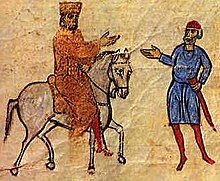Basil I.
Basil I the Macedonian ( Middle Greek Βασίλειος Αʹ ὁ Μακεδών Basíleios I. o Macedon , Latin Basilius I. Macedonicus , * around 812; † 29 August 886 ) was Byzantine emperor from 867 to 886.
Life
Basil came from an Armenian - Greek family who settled in the Byzantine theme of Macedonia . He spent part of his childhood in Bulgaria , where his family had lived since 813 as prisoners of the Bulgarian prince Krum . He managed to escape and was accepted as a groom in the service of Theophilitzes, a relative of Bardas , the uncle of Emperor Michael III. During a visit to the city of Patras , he won the affection of Danielis, a rich woman, who took him into her household and financed him. The emperor also noticed him when he won a wrestling competition and soon became his companion and bodyguard ( Parakoimomenios , see Offices and titles in the Byzantine Empire ).
In order to get Michael's favor, he divorced his wife Maria, with whom he had the son Constantine (* around 865; † September 3, 879) and married Eudokia Ingerina , one of Michael's mistresses . It is believed that Leo VI. 'Basil's son and successor, was actually the son of Michael.
Basil murdered - with the consent of the emperor - in April 866 to Kaisar Bardas, who had ruled the kingdom in Michael's name. On May 26, 866 he was crowned co-emperor, while Bardas' son-in-law, Symbatios , who was involved in the assassination, came away empty-handed. In September 867, Basil also killed Michael III, eliminated his rival Basiliskian and ascended the throne himself.

With the dynasty he founded, a new era began in the Byzantine Empire. It is commonly called the Macedonian Dynasty , although it would be more correct to call it the Armenian-Greek Dynasty . This time was a period of territorial expansion when the Empire was the strongest power in Europe.
He is often called the second Justinian because of his extensive legislative activity, which can be described as the revival of Justinian law . The Basiliká ("royal") collection of laws in 60 books, which was written by his successor Leo VI, goes back to Basil 's laws . was completed and put into effect. In addition, Basil initiated the creation of two smaller works known as Procheiron and Epanagoge .
Basil's financial conduct was reserved. His church policy is characterized by good relations with Rome . One of his first acts was the exile in 867 of the patriarch Photios I , who fought for the independence of the Byzantine Church, and the reinstatement of his rival Ignatios I , whose claims were supported by Pope Hadrian II . However, Basil had no intention of yielding to Rome beyond a certain point. The decision of the Bulgarian Tsar Boris I to place the new Bulgarian Church under the jurisdiction of Constantinople was an affront to Rome, which had expected this for itself. In 877, Photios was reinstated as patriarch, which in a sense represented the break with Rome - the decisive step in the conflict that led to the Eastern Schism and ultimately the separation between the Catholic and Orthodox Churches .

During the reign of Basil I there was an arduous war against the Paulicians left by his predecessor. The death of their military leader Johannes Chrysocheir and the conquest of the city of Tephrike by Basil I led in 872 to the final annihilation of the Paulicians, who had become a serious threat to the Byzantine Empire through an alliance of convenience with the Caliph of Baghdad . Furthermore, he realized 885, the Armenian kingdom of Bagratids Ashot I. on. Finally there was the "usual border war" with the Arabs. Cyprus was recaptured but could only be held for seven years. Syracuse was lost, Bari and large parts of Calabria were recaptured. The successes in Italy led to a new period of Byzantine dominance there. But above all, the Byzantines were again the masters of the Mediterranean, especially the Adriatic .
Basil ruled for 19 years. His death in August 886 is due to a fever he contracted after a serious hunting accident in which his belt got caught in a stag's antlers and he was pulled from his horse. He was saved by a servant who cut him loose with a knife. Basil, however, suspected the latter of wanting to murder him and had the servant executed shortly before he himself died.
literature
- Ralph-Johannes Lilie , Claudia Ludwig, Thomas Pratsch, Ilse Rochow, Beate Zielke: Prosopography of the Middle Byzantine Period . 1st department: (641−867). Volume 1: Aaron (# 1) - Georgios (# 2182). Created after preliminary work by F. Winkelmann . Published by the Berlin-Brandenburg Academy of Sciences. De Gruyter, Berlin 1999, ISBN 3-11-015179-0 , pp. 528-536 No. 20837.
- Alexios G. Savvides, Benjamin Hendrickx (Eds.): Encyclopaedic Prosopographical Lexicon of Byzantine History and Civilization . Vol. 2: Baanes-Eznik of Kolb . Brepols Publishers, Turnhout 2008, ISBN 978-2-503-52377-4 , pp. 50-53.
- Norman Tobias: Basil I (867-886). The founder of the Macedonian dynasty. A Study of the Political and Military History of the Byzantine Empire in the 9th century . Diss. Rutgers State University, New Brunswick NJ 1969.
- Mark Whittow: The Making of Byzantium, 600-1025 . University of California Press, Berkeley CA 1996, ISBN 0-520-20496-4 .
Web links
| predecessor | Office | successor |
|---|---|---|
| Michael III |
Emperor of Byzantium 867–886 |
Leo VI |
| personal data | |
|---|---|
| SURNAME | Basil I. |
| ALTERNATIVE NAMES | Basil the Macedonians |
| BRIEF DESCRIPTION | Byzantine emperor |
| DATE OF BIRTH | at 812 |
| DATE OF DEATH | August 29, 886 |
